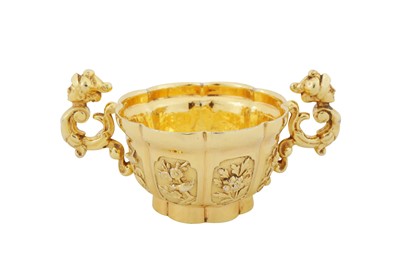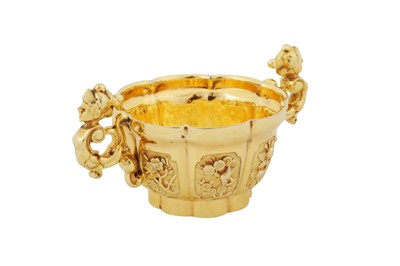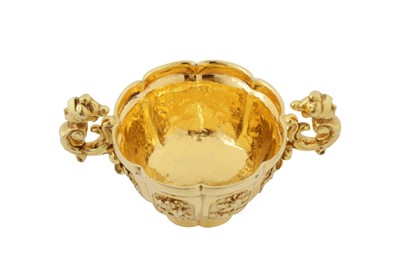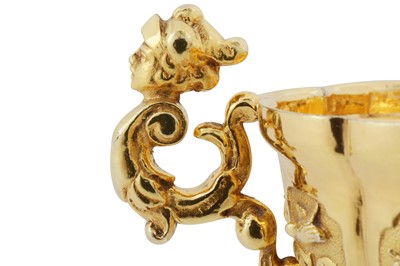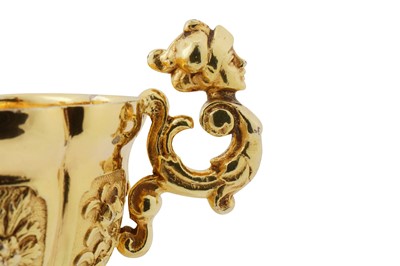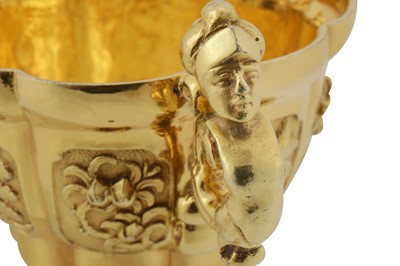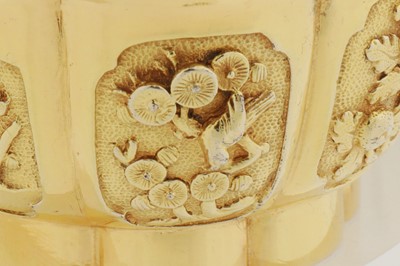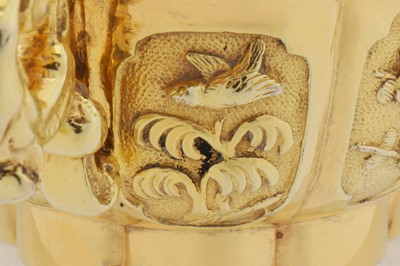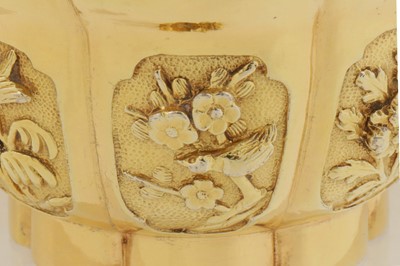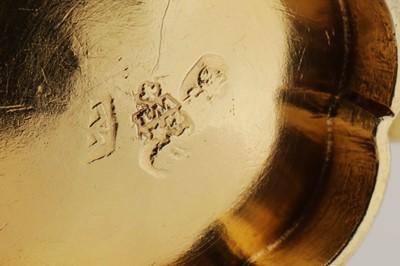23rd Mar, 2023 11:00
Silver and Objects of Vertu
An exceptional late 17th / early 18th century Chinese silver gilt tea bowl circa 1700, with Queen Anne Britannia standard handles, London 1705 by David Willaume I (1658-1741)
An exceptional late 17th / early 18th century Chinese silver gilt tea bowl circa 1700, with Queen Anne Britannia standard handles, London 1705 by David Willaume I (1658-1741)
Kangxi period. Of lobed octofoil form upon an octofoil collet foot, with cast twin handles of bifurcated scroll handles with caryatid terminals of classical helmeted male busts. The body with cast and applied chinoiserie decoration of alternating panels of leafy fruit, birds among pine trees, flowering prunus, chrysanthemums, a bird flying over palms. Fully marked underneath.
Length – 9.8 cm / 3.8 inches-
Weight – 142 grams / 4.57 ozt
This tea bowl, which is part of a disbanded set as two further examples previously with How of Edinburgh are now in the collection of the Aga Khan, is an exceptional example of the interaction between the little known first phase of Chinese Export silver and Baroque silverware of the Huguenot class of London silversmiths. The cast and applied then chased decoration is Chinese Export is combined with the undeniably Baroque feature of the caryatid-type handles, more prominently seen on the great ewers of the late 17th and early 18th century by the Anglo-Huguenot class. Previous spectrographic analysis of this bowl reveals it to have been alloyed with iron, something that does not present in English silversmithing but is typical of early Chinese production. The handles, which are of a distinctly Huguenot style as opposed to chinoiserie would be slightly later additions to help combat the heat of the vessel during use. As tea drinking developed in early 18th century Britain it becomes apparent that English taste was to serve tea much hotter than consumed on the Orient. Silver tea bowls and saucers, which are a rare occurrence in English silver from the 1680’s, do not lend themselves comfortably to this method of consuming tea due to heat conductivity. It is known that in European use tea was poured from the Chinese Export porcelain tea bowl into its saucer to aid cooling it, as with coffee as seen in the 1741 painting of Governor-General V. Levendal with his wife. The English setting can be seen in Richard Collins essential painting A Family of Three at Tea (c. 1727) housed in the V&A (P.9&:1-1934)
Early examples of this first phase of Chinese export silver, while bearing London hallmarks, have thanks to recent spectrographic analysis been confirmed of Chinese origin such as the teapot of 1682 (Peabody Museum). There are also the works bearing the mark PD crowned within this chinoiserie group alongside another snuff box possibly marked EB sold Christie’s New York, 16 April 1999, lot 228 ($14,375 incl. prem) as well as a late 17th / 18th century bowl and cover, mounted on Regency silver plinths with its facsimile of 1810 sold Christie’s London, 10 Feb 2022, lot 109 (£237,500 incl. prem). An unmarked late 17th century tankard of this first phase Chinese Export origin was sold in Dreweatts, 14 July 2016, lot 53. The decoration of pine trees, birds and chrysanthemums being in keeping with this lot, spectrographic analysis of other items in this group has revealed purities up to 980, suitably more than the Britannia standard of 958, hence the marks upon this piece.
Academic discussions on the origin and history of Chinese silver items and the interaction of the European-Chinese trade has been thoroughly discussed by Philippa Glanville, Silver in England, (1987), pp. 233-236. For the purposes of context the passages most related to the current lot are:
A hoard discovered some years ago at Tung Dao, deposited about 1647, which included shaped plates, wine cups and saucers, demonstrates that the features regarded as distinctively Chinese, shaped borders, chasing, ring matting to provide a textured background and so on, which had been typical of Chinese silver certainly since the 12th century if not long before, were still to be found in the 17th century. This is a crucial link in the chain of evidence since it is the sudden appearance of these features on English and Dutch silver of the 1680s and later which can only be explained in terms of Chinese work in the precious metals suddenly arriving in Europe at this period. […]
The presence of Chinese-manufactured silver and goldsmiths’ wares in Europe by 1700, if not ten or fifteen years before, is indisputable. While it must be admitted that no one piece can be proven as yet to have arrived in Europe before 1700, we have the evidence both of English and Dutch copies of Chinese metalwork (copies which reproduce those features mentioned above as characteristic of Chinese work of the 17th century), and an engraved design issued by a goldsmith in 1694. This is one in a suite of designs published by De Moelder in London and perhaps also in the Netherlands. […]
Indisputably English are three tea bowls by David Willaume of 1712 and also presumably English is a chafing dish by Antony Nelme, the latter with the recessed ornament chased and embossed rather than applied.
Provenance:
Sold Christie’s London, Scone Palace and Blairquhan The Selected Contents of Two Great Scottish Houses, 24 May 2002, lot 548 (£18,600 incl. prem)
David Willaume I (1658-1741)
Son of Adam Willaume goldsmith of Metz on the pont des Morts and Anne Phillipe his wife, born 7th June 1658. He presumably learnt his trade from his father or another Metz goldsmith. His denization appears in the State Papers, Carr. II, Entry Book 67, under date 16 December 1687, where the name is spelt Williamme, (or Villiamme). Heal's reference to him, therefore as being in London in 1674 is an error, perhaps deriving from a misattribution of a mark. He does, however, record Willaume at the Windsor Castle, Charing Cross from 1686, by which time he may well have reached London, Denization following later. He married at the French Chapel of La Patente, Spitalfields, October 1690, Marie daughter of Samuel Matteyer, Minister of that church and sister of Lewis Matteyer. Free by order of the Court of Aldermen as David Williams 27 January 1693/4. Livery, October 1698. Court, February 1724/5. First mark as largeworker, undated, probably April 1697 on commencement of register. Address:'in the pell-mell'. Second and third marks added to the first entry, 29 January 1719. Address: St James's Street. Fourth mark, 27 July 1720, same address. Heal records him as David Willaume senior goldsmith and banker, London, 1674-1712, of which the first date is erroneous; and Windsor Castle, Charing Cross, 1686-90; and Golden Ball, Pall Mall, 1697-1712. Heal gives the St. James's Street address only to David Willaume II, but it is clear that the father was in St James's Street by January 1719, where Chaffers states he is recorded as 'running cahes'; the 1720 entry appears to be his son's hand, although he was not free till 1723, presumably acting for his father. He is also recorded by Hilton Price, (Handbook of London Bankers). The children of his marriage were Anne, born 1691, wife of David Tanqueray, David , born 1693 and Adam and Suzzane born 1694 and 1696, both dead in infancy. Willaume makes frequent appearances in the Huguenot church registers of London as witness or godfather, and it is clear he was an outstanding member of the community. He first appears as godfather to David Surel at Hungerford Market Church, 5 August 1688, and 'assisted' at the marriage of his sister-in-law Marie Mettayer to Simon Gribelin, the engraver 1 January 1691 at La Patente, Spitalfields, which was the church at which Simon Mettayer was minister.
Willaume appears to have retired about 1728 (when David II entered a mark of distinctly different type to his father, and purchased the manor of Tingrith, Bedfordshire in 1730, from which time the family became seated there, inter-marrying with the Tanqueray's and later being styled Tanqueray-Willaume. He died before 22nd January 1741. From his surviving work, Willaume enjoyed the patronage of the wealthiest clients in England from the latter part of the first three decades of the 18th century.
A short list of important works:
1698 Pair of wine coolers. Duke of Devonshire
1699 Ewer and dish. Queen's College, Cambridge
1699 Pair of sconces. Lord Brownlow
1700 Ewer and dish. Duke of Portland
1701 Ewer and dish. Duke of Abercorn
1701 Wine Fountain. Duke of Buccleuch
1704 etc. Toilet service. Luton Hoo Collection
1706 Ewer and dish. Fishmonger's Company
1708 Wine-cistern and fountain. Duke of Brunswick
1713 Punch bowl and cover. Trinity Hall, Cambridge
1718 Ewer and dish. Ex Hearst Collection 1938
1725 Toilet service. Ex Collection of Viscount Cowdray
1726 Ewer and dish. Earl Fitzwilliam
Sold for £18,750
Includes Buyer's Premium
Do you have an item similar to the item above? If so please click the link below to submit a free online valuation request through our website.



